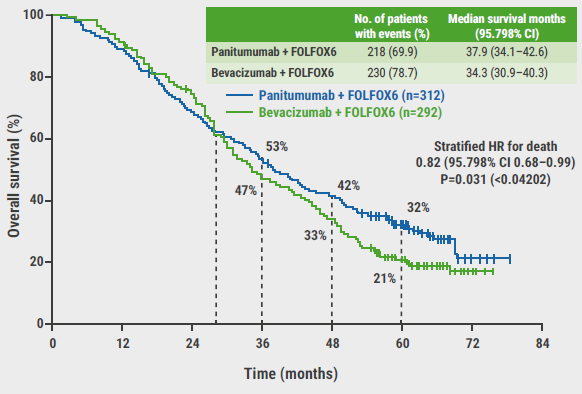https://doi.org/10.55788/b86680bc
Bendamustine-rituximab has become the most commonly used first-line regimen for older patients with mantle cell lymphoma [1]. The Bruton’s tyrosine kinase (BTK) inhibitor ibrutinib has transformed the care of patients with relapsed/refractory mantle cell lymphoma [2]. The phase 3 SHINE trial (NCT01776840), presented by Prof. Michael Wang (Anderson Cancer Center, TX, USA), randomised 523 older patients (≥65 years) with untreated mantle cell lymphoma 1:1 to 6 cycles of bendamustine-rituximab plus ibrutinib and rituximab maintenance therapy or bendamustine-rituximab plus placebo and rituximab maintenance therapy [3]. The primary endpoint was PFS.
After a median follow-up duration of 7.1 years, the PFS was significantly higher in the ibrutinib arm than in the placebo arm (6.7 vs 4.4 years; HR 0.75; P=0.011; see Figure), representing a 25% reduction in risk of disease progression or death in the combination therapy arm. The results were mostly consistent across subgroups, with the exception of high-risk patients, in whom the PFS results were comparable (HR 1.02). Notably, the OS appeared not to differ between the experimental arm and the placebo arm, with 55% and 57% survival after 84 months, respectively. However, the OS results were not yet mature at the time of the presentation.
Figure: Progression-free survival of ibrutinib versus placebo in addition to bendamustine-rituximab [3]

PFS, progression-free survival; BR, bendamustine-rituximab.
Neutropenia was the most common adverse event, occurring in approximately 50% of the patients in each arm. Rash and pneumonia were more common in the experimental arm, as well as atrial fibrillation (13.9% vs 6.5%), and bleeding of any grade (42.9% vs 21.5%). However, the rate of major bleedings was comparable (5.8% vs 4.2%).
Prof. Kerry Savage (University of British Columbia, Canada), discussant of this trial, argued that the results of the SHINE trial support bendamustine-rituximab plus ibrutinib as a first-line treatment option for older or transplant-ineligible patients with mantle cell lymphoma, especially for those who display a good performance status. “Careful selection of patients is still needed, since the safety analysis showed increased rates of neutropenia, infections, and cardiac complications in the combination arm. Finally, mantle cell lymphoma is clinically and biologically diverse and we need to implement the use of BTK inhibitors in personalised approaches for our patients.”
- Martin P, et al. J Clin Oncol. 2021;(39):7504–7504.
- Wang ML, et al. N Engl J Med. 2013;369:507–516.
- Wang ML, et al. Primary Results From the Double-Blind, Placebo-Controlled, Phase III SHINE Study of Ibrutinib In Combination WithBendamustine-Rituximab and Rituximab Maintenance as a First-Line Treatment for Older Patients With Mantle Cell Lymphoma. LBA 7502, ASCO 2022 Annual Meeting, 3–7 June, Chicago, IL, USA.
Copyright ©2022 Medicom Medical Publishers
Posted on
Previous Article
« Promising results for novel CAR-T therapy in relapsed/refractory multiple myeloma Next Article
Autologous stem cell transplantation plus RVd improves PFS in multiple myeloma »
« Promising results for novel CAR-T therapy in relapsed/refractory multiple myeloma Next Article
Autologous stem cell transplantation plus RVd improves PFS in multiple myeloma »
Table of Contents: ASCO 2022
Featured articles
Breast Cancer
Sacituzumab govitecan meets primary endpoint
Shaky OS results of palbociclib in ER-positive/HER2-negative breast cancer
Practice-changing results of T-DXd in HER2-low breast cancer
SET2,3 to inform on chemotherapy decisions in ER-positive breast cancer
Metastasis-directed therapy fails in oligometastatic breast cancer
Analysis by residual cancer burden further clarifies effect of pembrolizumab
Contribution of metastatic therapies on mortality reduction in breast cancer
Radiotherapy may be omitted in breast cancer patients
Promising data for ribociclib after progression on ET plus CDK4/6 inhibitors in HR-positive/HER2-negative metastatic breast cancer
7-gene biosignature: Benefits of endocrine therapy and radiotherapy in breast cancer risk groups
Lung Cancer
Additional tiragolumab does not help patients with untreated small cell lung cancer
Success for serplulimab plus chemotherapy in small cell lung cancer
Adagrasib safe and clinically active in non-small cell lung cancer
Long-term benefits of combined immunotherapy over chemotherapy in non-small cell lung cancer
Effect of KRAS mutations and PD-L1 expression on therapy response in non-small cell lung cancer
Melanoma
First results on distant metastasis-free survival in stage II melanoma
Higher response rates for concurrent triple therapy versus sequential therapy in melanoma
Genitourinary Cancers
Exploratory treatment options fail in ccRCC
Adjuvant everolimus did not benefit high-risk renal cell carcinoma
Cabozantinib fails as first-line maintenance therapy in urothelial cancer
177Lu-PSMA-617 is a valid treatment option for PSMA-positive mCRPC
Enzalutamide performs well in metastatic hormone-sensitive prostate cancer
Haematologic Malignancies
Autologous stem cell transplantation plus RVd improves PFS in multiple myeloma
Novel first-line treatment option for mantle cell lymphoma
Promising results for novel CAR-T therapy in relapsed/refractory multiple myeloma
Gastrointestinal Cancers
Panitumumab beats bevacizumab in RAS wildtype left-sided metastatic colorectal cancer
Spectacular results for dostarlimab in mismatch repair deficient rectal cancer
Triplet chemotherapy beats doublet chemotherapy in colorectal cancer liver metastases
To resect or not to resect primary tumours in stage IV colon cancer?
Novel treatment option for KRAS wildtype pancreatic cancer
Gynaecological Cancers
Primary results of rucaparib in ovarian cancer
Trabectedin not superior to chemotherapy in recurrent epithelial ovarian cancer
Encouraging results of relacorilant in ovarian cancer
Miscellaneous Topics
Bacterial decolonisation effective against radiation dermatitis
New standard-of-care for cisplatin-ineligible locally advanced head and neck squamous cell carcinoma
Ifosfamide is likely to be the go-to therapy in recurrent Ewing sarcoma
Dabrafenib plus trametinib candidates for standard-of-care in BRAF V600-mutated paediatric low-grade glioma
Related Articles
August 5, 2022
Primary results of rucaparib in ovarian cancer

© 2024 Medicom Medical Publishers. All rights reserved. Terms and Conditions | Privacy Policy
HEAD OFFICE
Laarderhoogtweg 25
1101 EB Amsterdam
The Netherlands
T: +31 85 4012 560
E: publishers@medicom-publishers.com

